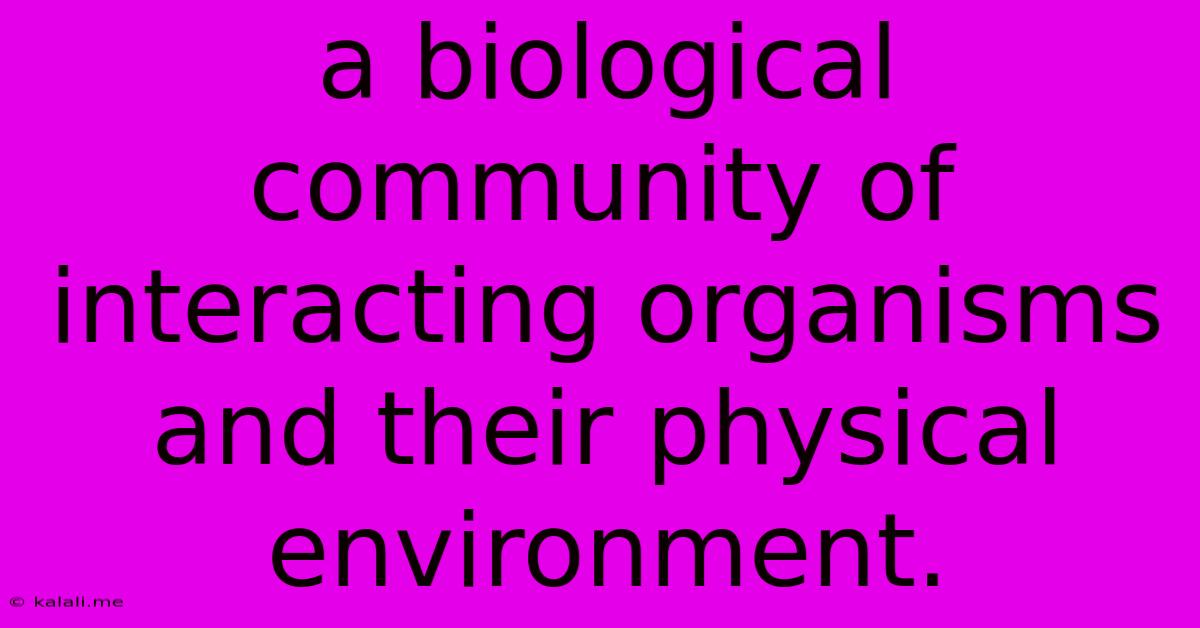A Biological Community Of Interacting Organisms And Their Physical Environment
Kalali
Jun 12, 2025 · 3 min read

Table of Contents
Exploring the Dynamic Dance of Life: A Biological Community and its Environment
Meta Description: Discover the fascinating interplay between organisms and their environment within a biological community. Learn about key concepts like biodiversity, trophic levels, and the impact of environmental changes on community structure and function.
A biological community, often referred to as a biocoenosis, is a vibrant tapestry woven from countless interacting organisms inhabiting a shared physical environment. This environment, encompassing both biotic (living) and abiotic (non-living) factors, shapes the community's structure, function, and resilience. Understanding this intricate relationship is fundamental to comprehending the complexities of the natural world.
Defining the Components: Biotic and Abiotic Factors
The biotic factors encompass all living components, including plants, animals, fungi, bacteria, and protists. These organisms engage in a myriad of interactions – competition for resources, predation, symbiosis (mutualism, commensalism, parasitism), and more. The abiotic factors, on the other hand, are the non-living elements like temperature, sunlight, water availability, soil composition, and air quality. These factors dictate the boundaries within which the community can thrive. For instance, a desert community is shaped by high temperatures, low water availability, and intense sunlight, while a rainforest community thrives in conditions of high humidity, ample rainfall, and dense shade.
Unveiling the Structure: Biodiversity and Trophic Levels
The structure of a biological community is intricately linked to its biodiversity, which refers to the variety of life at all levels, from genes to ecosystems. High biodiversity generally indicates a healthy and resilient community, capable of withstanding environmental stresses. Conversely, low biodiversity makes the community vulnerable to disturbances.
Another crucial aspect of community structure lies in its trophic levels. These represent the different feeding levels within a community. Producers (plants and some bacteria) form the base, converting sunlight into energy through photosynthesis. Primary consumers (herbivores) feed on producers, secondary consumers (carnivores) feed on primary consumers, and tertiary consumers (top predators) occupy the apex. Decomposers (bacteria and fungi) play a vital role in breaking down organic matter, recycling nutrients back into the ecosystem. The intricate network of these feeding relationships forms the community's food web.
Ecological Interactions: The Driving Forces of Change
The interactions between organisms within a community are constantly shaping its dynamics. Competition arises when organisms vie for the same limited resources, influencing population sizes and species distribution. Predation significantly impacts prey populations and can drive evolutionary adaptations in both predator and prey species. Symbiotic relationships, encompassing mutualism (both organisms benefit), commensalism (one benefits, the other is unaffected), and parasitism (one benefits, the other is harmed), further contribute to the community's complexity.
Environmental Change and Community Dynamics
Biological communities are not static entities; they constantly respond to changes in their environment. Climate change, habitat destruction, pollution, and the introduction of invasive species can significantly alter community structure and function. These changes can lead to species extinctions, shifts in species abundance, and alterations in ecosystem services. Understanding these impacts is crucial for implementing effective conservation strategies.
Ecosystem Services and Human Well-being
Biological communities provide invaluable ecosystem services that underpin human well-being. These services include clean water and air, pollination of crops, climate regulation, and soil formation. The degradation of these communities, therefore, has far-reaching consequences for human societies.
In conclusion, a biological community is a complex and dynamic system, shaped by the intricate interactions between organisms and their environment. Understanding this interplay is crucial for appreciating the beauty and fragility of the natural world and for developing strategies to conserve biodiversity and ensure the continued provision of vital ecosystem services. Further research into specific community structures, their responses to environmental pressures, and the implications for human well-being is essential for a sustainable future.
Latest Posts
Latest Posts
-
Which Of The Following Is True About A Firewall
Jun 13, 2025
-
Difference Between Animal And Plant Mitosis
Jun 13, 2025
-
What Is The Multiples Of 13
Jun 13, 2025
-
Which Of The Following Is Not An Enzyme
Jun 13, 2025
-
Difference Between Lok Sabha And Vidhan Sabha
Jun 13, 2025
Related Post
Thank you for visiting our website which covers about A Biological Community Of Interacting Organisms And Their Physical Environment . We hope the information provided has been useful to you. Feel free to contact us if you have any questions or need further assistance. See you next time and don't miss to bookmark.